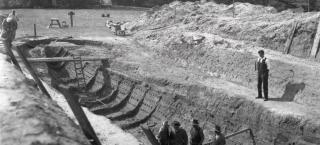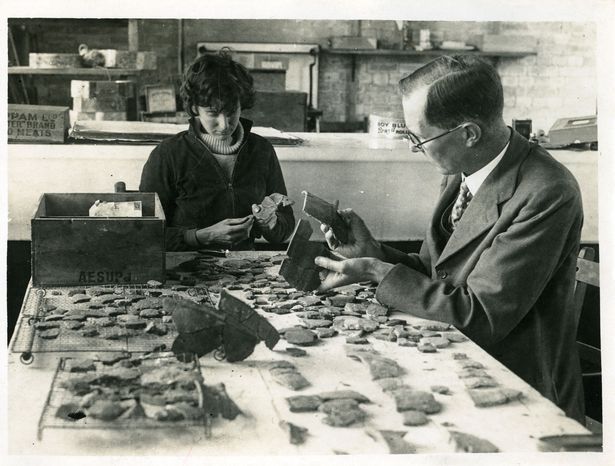
Story
Ancient History, New on Netflix
An Archaeologist Reviews “The Dig”
Netflix released the drama film The Dig on January 29. Archaeologist Chris Bowles reviews the film and provides additional context to the history of the excavation and the overall discovery.
When I was growing up on the Front Range in the 1980s, two movies profoundly impacted my life. The first was Raiders of the Lost Ark, which, along with my dad’s insistence that we visit every single frontier fort in Colorado and Wyoming, led me towards a lifelong love of archaeology. The second was Excalibur, with its moody medieval vignettes channeling Glam Rock while echoing Sir Thomas Malory’s romantic epic Le Morte d’Arthur. Both movies led me to a fascination with the archaeology of early medieval (roughly 450–1100 AD) Britain, a Ph.D. in the subject, and a 20-year stint living in Scotland and absorbing it in my bones.
When I saw that Netflix would bring me the story of the greatest early medieval discovery of the 20th century—a royal Anglo-Saxon boat burial at Sutton Hoo, Suffolk—I was beyond excited. The Dig channels everything about early medieval archaeology that I love: the mystery, the glamor, and even the extraordinary characters of previous generations of archaeologists that I’ve come to know through their work.
The movie recounts the efforts in 1939 of the aristocratic landowner Edith Pretty (Carey Mulligan) to investigate a series of strange mounds on her Sutton Hoo estate. She enlists the help of a local amateur “excavator” Basil Brown (Ralph Fiennes) to help her reveal the mysteries of the earthworks. The understated, humble, but extremely knowledgeable Basil begins very simply by laying out a trench and cutting the turf with a mattock. Basil and Edith quickly develop a close friendship, despite their noticeable class differences, through their excitement for the dig and love of archaeology. There develops a sense of community and even family surrounding the dig, mostly through Edith’s 10-year-old son Robert (Archie Barns) who looks to Basil as a father figure. Despite setbacks (trigger warning: this is not a film for people afraid of being buried alive!), the small team of diggers uncover the single greatest discovery of early medieval archaeology to that point, and arguably to this day: a buried ship containing at its center the remnants of a burial.
As word of the discovery gets out, the local museum and the British Museum in London send in “professional” archaeologists to take over. British Museum archaeologist CW Philips leads this effort and is joined by a virtual pantheon of archaeologists who would in their own right come to define prehistoric and early medieval archaeology for decades to come. Two of the assistants, Stuart (Ben Chaplin) and Margaret “Peggy” Piggott (Lily James), are the subject of a key side story in the second half of the movie.

Basil Brown was a local archaeologist, who is most famous for his excavations of the burial mounds at Sutton Hoo in Suffolk.
As both an early medievalist and a fan-boy, I loved this movie. It captures so much in such a short space of time that it’s difficult to recount it all here. What really struck a chord with me was the quiet anticipation, and the slow-burning drama between all the characters. Having been on many digs, this sometimes happens and when it does it’s memorable. It has to be said outright that Fiennes’ Basil Brown is a perfect study of the understated English working class of the time that “just got on with it” despite all the turmoil and growing horror that was gripping Europe—shown in the movie by the occasional Spitfire squadron flying overhead during the Battle of Britain. Without Fiennes’ expert restraint as an actor, and the ability to show his characters’ motivations through his eyes and few words, I doubt the movie would have succeeded. Carey Mulligan also provides a stand-out performance as a woman torn between her family legacy and the desire to discover something truly life-affirming, despite being cast as a woman who in reality was in her late 50s. There are no bad performances in this movie, and it’s worth watching for that reason alone.
There is one main character who doesn’t get any screen time, unfortunately. That’s King Raedwald of East Anglia, who most scholars now believe was the man buried beneath the mound at Sutton Hoo. Raedwald lived in the 7th century AD during a time of constant warfare as Anglo-Saxon, Welsh, Cornish, Scottish, and Pictish warlords established kingdoms across Britain in the ruins of the once prosperous Roman province of Britannia. Eventually these kingdoms would coalesce into the countries that comprise the United Kingdom, but this process would take 1,000 more years of political intrigue and bloodshed. Raedwald, a Germanic speaking Angle, was among the first kings to rule large parts of what would become England after defeating the Northumbrians (centered on the Humber River in north-eastern England) in battle and installing a puppet king. As might be expected for one who claimed to be Bretwalda (ruler of all Britain), his burial was both elaborate and monumental. The ostensibly pagan, and very Germanic, burial in a ship beneath a highly visible mound showed his (or at least his people’s) desire to see him well-apportioned in the afterlife. He was given coins, drinking horns, weaponry, and an amazing helmet that proved him a warrior to the gods he was going to meet. Burial mounds are a hallmark of the pagan Germanic cultures, including the later Vikings, across northern Europe. They are intentionally visible, marking out the cemeteries and territories of the ruling class. There were a number of other mounds at Sutton Hoo, as shown in the movie, at least one of which also later proved to be a ship burial.
This was the cemetery of a ruling class looking to cement their hold over a troubled land through monuments reflecting an overtly pagan cosmology. But, as pointed out in The Dig, Raedwald’s ship and burial were oriented east to west, which may suggest an already tacit acceptance of Christianity. In fact, we know through the Anglo-Saxon Chronicle that Raedwald was among the first Germanic kings in Britain to be baptised. Through the work of missionaries such as St Germanus, St Columba and St Patrick, by the end of the 7th century, nearly all of the elites in Britain and Ireland were Christian and tied through politics and religion to all other Christian rulers across Western Europe. The discovery of an elaborate burial to a Christian king at Sutton Hoo was significant because, up until that point, the Anglo-Saxons were seen as base barbarians by classically trained British scholars firmly attached to the notion that the British Empire was a direct successor to the Roman Empire.

Peggy Piggott when she was aged 23 examining objects from an excavation four years before the Sutton Hoo dig. She is shown with archaeologist E. Cecil Curwen
While I have some background knowledge of Sutton Hoo which added to my enjoyment, you don’t need it to understand the importance of the find, or the tensions surrounding its discovery, and fall in love with the movie. I did have one issue, however. A significant part of the film was given to a rift between the married archaeologists Stuart and Peggy Piggott. In real life, the Piggotts were two of the most prominent archaeologists of their generation, whose work in the field is still felt. Far from being the slightly bumbling novice as portrayed by Lily James, Peggy Piggott was a very experienced archaeologist, published scholar, and central to Sutton Hoo’s excavation. Given the undoubted difficulties that the real Peggy must have encountered both personally and professionally to get to where she was by 1939, her expertise should have shone in this portrayal. Likewise, by this time Stuart Piggott was an expert in his field. This is why the British Museum brought them to Sutton Hoo to work under CW Philips, preeminent in early medieval and Roman archaeology. The film establishes immediate tension between Peggy and Stuart, and a subtle hint that Stuart may have been having a relationship with John Brailsford. Unfortunately, it strikes me that the whole subplot was deployed to make the movie more exciting than the dig was. The Piggott’s marriage did eventually break up, as suggested in the film, but not until 1956 after they moved to Scotland where Stuart became Abercromby Chair of Archaeology at the University of Edinburgh. Together, they excavated many of Scotland’s most important Iron Age and early medieval sites, including a number in the Scottish Borders that I’m intimately familiar with from my studies. After their divorce, Peggy married a Sicilian named Luigi Guido, although their marriage fell apart soon after. To many archaeologists of my generation, Margaret Guido’s brilliant work in typologies and comparative analysis from the 1950s to the day she died in 1994 will remain a gold standard. I feel Peggy’s real genius is missing from the story, instead, the movie relegates her character to one pining for love and recognition.
There are a few more liberties in the film that I won’t dive into in this article. It is a movie, after all. The performances (particularly Ralph Fiennes), the scene setting, and more or less accurate portrayal of the discovery at Sutton Hoo, make The Dig one of the best archaeology movies I’ve ever seen—although I still have a soft spot for Raiders of the Lost Ark.

